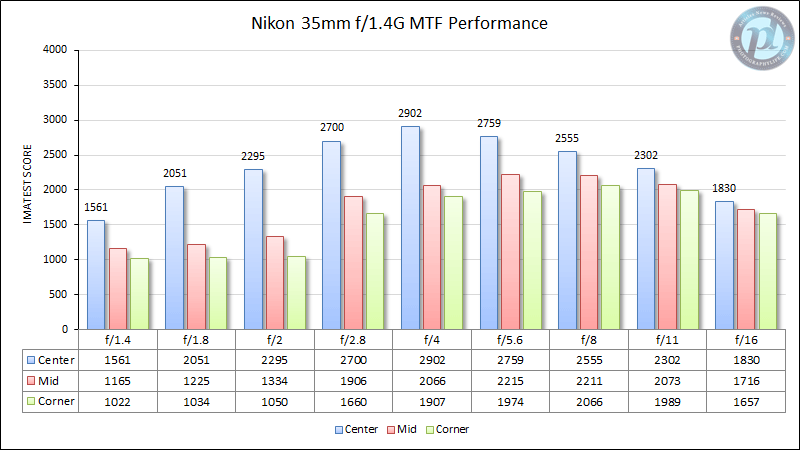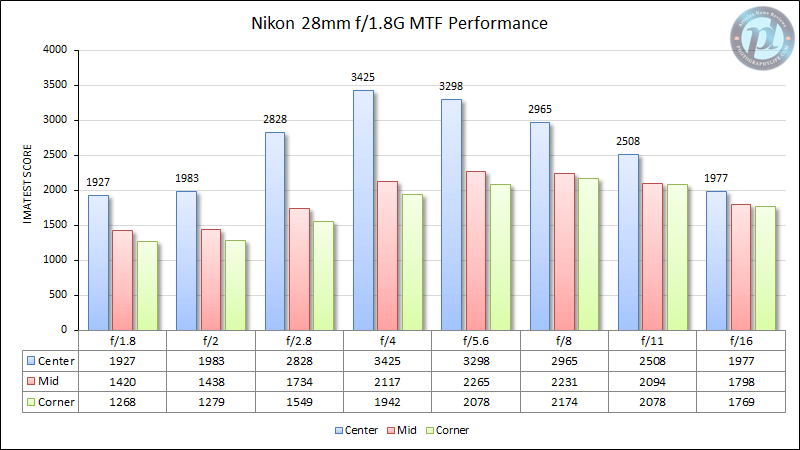Nikon 35mm f/1.8G ED vs Nikon 35mm f/1.8G DX
If you already own the Nikkor 35mm f/1.8G DX and wonder how it would fare against the Nikkor 35mm f/1.8G ED full-frame lens, then you might find the below results interesting. Please note that the 35mm f/1.8G DX does produce rather heavy vignetting at close distances, as shown earlier, so its corner figures are definitely impacted as a result:


It is impressive to see the 35mm f/1.8G DX lens perform on a full-frame camera with big enough of image circle to cover most of the FX frame, so if you do not mind the heavy vignetting at close distances, the results can be quite good. Sharpness-wise, the 35mm f/1.8G ED is stronger in the center, while the DX is not bad either, especially at large apertures. The biggest difference is corner performance – that’s where the 35mm f/1.8G DX suffers quite a bit at large apertures. However, once stopped down to f/5.6, sharpness picks up quickly.
Given that the 35mm f/1.8G DX is half the cost of the 35mm f/1.8G ED lens, I would say that you get a lot of value from that little lens…

Nikon 35mm f/1.8G ED vs Nikon 35mm f/1.4G
Now let’s take a look at how the 35mm f/1.8G ED compares to the bigger, heavier and more expensive 35mm f/1.4G:


When I first saw the above figures, I honestly had a hard time believing that the Nikkor 35mm f/1.4G would do so much worse in comparison. Its wide open performance at f/1.4 is rather weak and the Nikkor 35mm f/1.8G ED still outperforms it at f/1.8, especially in mid-frame and corners. The biggest difference, however, can be seen when both lenses are stopped down to f/4 – the Nikkor 35mm f/1.4G seems to be noticeably weaker in the center and about the same in mid-frame and corners.
At the same time, you should keep in mind that it is common for f/1.8 lenses to outperform f/1.4 lenses in sharpness alone, as we had previously seen with other Nikkor primes. Expensive pro-level f/1.4 primes aim for better aesthetics, colors, microcontrast, bokeh and superior handling of distortion, vignetting and CA, so they are not typically optimized to yield maximum sharpness. Without a doubt, the Nikkor 35mm f/1.4G produces more aesthetically pleasing images than the 35mm f/1.8G ED and that’s what you pay the big bucks for.

Nikon 35mm f/1.8G ED vs Sigma 35mm f/1.4 Art
The last comparison is between the Nikkor 35mm f/1.8G ED and the Sigma 35mm f/1.4 Art. When I initially tested the Sigma 35mm f/1.4 Art, I was stunned by its sharpness. Let’s take a look at how the two compare sharpness-wise:


You can now see why I said that the copy of the Nikkor 35mm f/1.8G ED I tested was rather unusual – its peak performance wide open almost matches that of the Sigma 35mm f/1.4 Art, which previously held the record for the sharpest 35mm f/1.4 lens I’ve tested. How much difference is there between these numbers? Very little – you will never be able to tell by looking at the two with your eyes. Simply put, both lenses will look equally sharp in the center. At f/2.0, the two seem to be equivalent in sharpness, and stopped down, the Sigma 35mm f/1.4 Art is a bit better in mid-frame, while being weaker in the corners.

Again, don’t judge the performance of lenses based on sharpness alone. The Sigma 35mm f/1.4 Art has superior optics when it comes to handling of distortion, vignetting, CA and bokeh, so it also produces images that are more aesthetically pleasing.
Nikon 35mm f/1.8G ED vs Nikon 28mm f/1.8G
Lastly, our readers have asked to provide a comparison to the Nikkor 28mm f/1.8G, so here it is:


The 28mm f/1.8G starts out a bit weaker in center resolution at f/1.8, but its mid-frame and corner performance are pretty impressive – it is visibly sharper compared to the 35mm f/1.8G ED there. As you stop it down to f/4 and smaller, the 35mm f/1.8G ED catches up pretty quickly and more or less evens out. However, it is pretty clear that the 35mm f/1.8G ED is superior in the center at all apertures.

Table of Contents